Several years ago, a pair of posts examined two important trends in the Wisconsin Court of Appeals: (1) the sharp decline in the total number of decisions issued, and (2) the decreasing percentage of those decisions that were published. Both trends matter because they affect the volume of precedential authority available to the legal community and the number of cases eligible for supreme court review. With six more years of data now in hand, this update takes another look at what has—and hasn’t—changed.
Number of Court of Appeals Decisions
Over the past few decades, the total number of decisions (summary dispositions, per curiam decisions, and authored opinions—published and unpublished) has fallen, with momentum that continued through 2024, as illustrated in the table and graph below.[1]
Published Decisions
The previous post found that not only did the total number of court of appeals decisions decline, so did the subset of published decisions. This trend is especially concerning because only published decisions may be cited as precedential authority. Unpublished decisions retain, at most, merely “persuasive value.” They are not binding, and neither lower courts nor parties are required to address them.[2] Thus, the dwindling number of published decisions left the legal community with an ever-smaller amount of guidance.
At the start of the 21st century, the court of appeals issued about 300 published decisions annually. By 2018—the final year covered in the previous study—that number had fallen to just 60. One might have guessed that the contraction would continue over the next six years, as it did for the total number of decisions, but such was not the case. As displayed in the following table and graph, the quantity of published decisions remained at roughly the 2018 level—historically low, but at least stable.
3-Judge Opinions
Most court of appeals decisions are unsigned or appear over the name of a single judge, but some are issued by full three-judge panels. Although three-judge decisions are often unpublished, virtually all decisions that are published by the court of appeals come from these full panels. Thus, given the importance of published decisions, it’s worth taking a moment to note an interesting development regarding three-judge output.
The total number of three-judge decisions—both published and unpublished—continued to fall over the last six years, from 165 in 2019 to just 95 in 2024. Yet the number of published three-judge decisions (which had dropped sharply from the beginning of the century down to 2018) held fairly steady thereafter. Consequently, the percentage of all 3-judge rulings that were published decisions shot up dramatically over the past six years, as shown in the following table and graph, reaching a percentage in 2024 (66%) close to the figure (69%) for 2001.[3]
[1] Consolidated cases are counted as only one. During the 1990s, the total number of decisions ranged between 1300 and nearly 2000.
This post does not address the question of why the decline occurred, but one factor to consider is the smaller number of cases reaching the court of appeals in the first place: 1601 cases submitted on briefs or (rarely) with oral argument in 2001, down to 874 cases in 2024.
[2] Wis. Stat. § 809.23.
[3] A muted version of this development is evident regarding the total number of court of appeals decisions (3-judge, 1-judge, per curiam, and summary dispositions taken together). That is, the percentage of all decisions represented by those that were published stopped declining after 2018 and then moved at least slightly higher beginning in 2020.
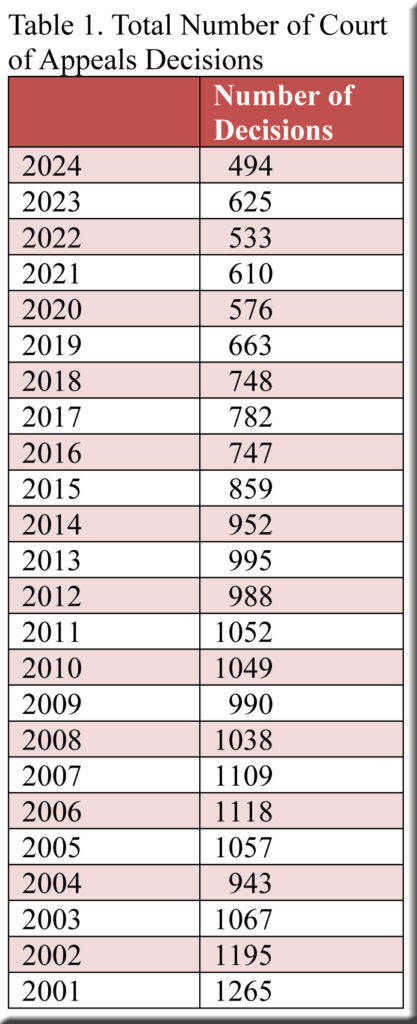
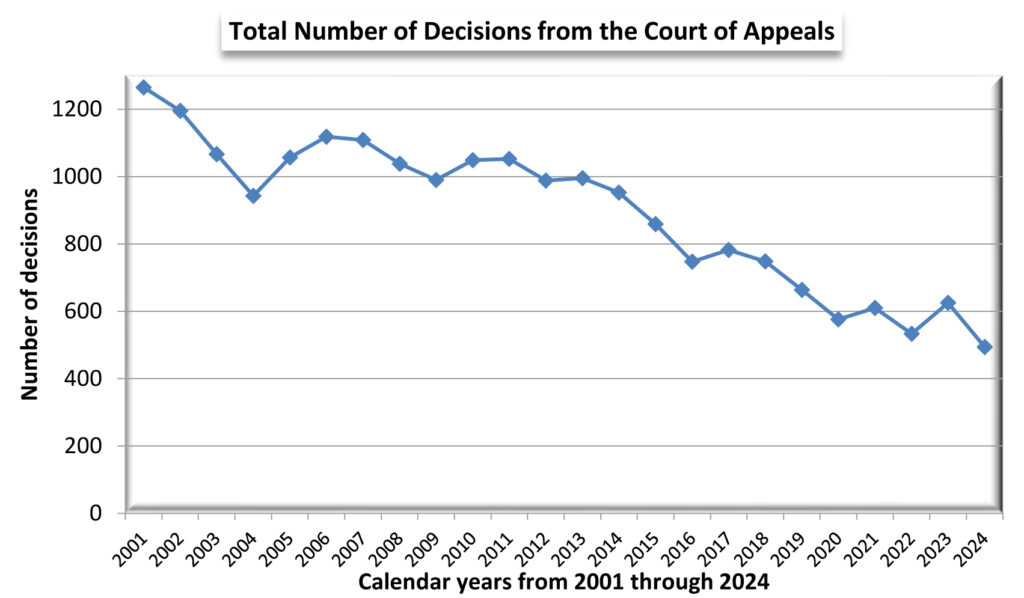
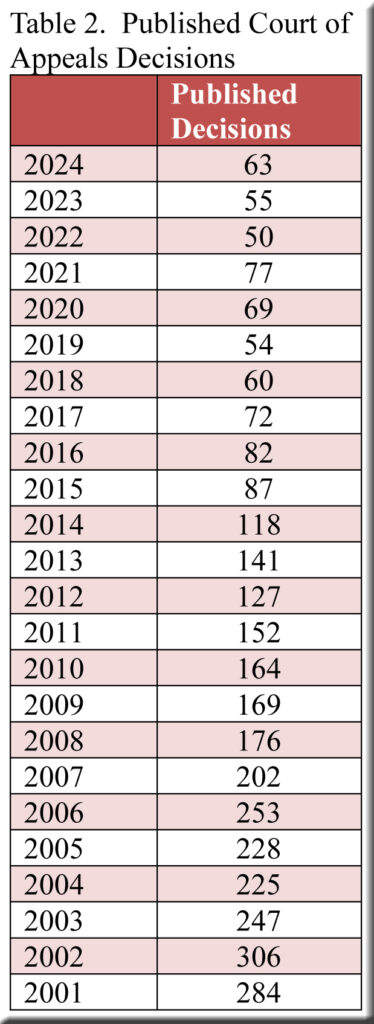
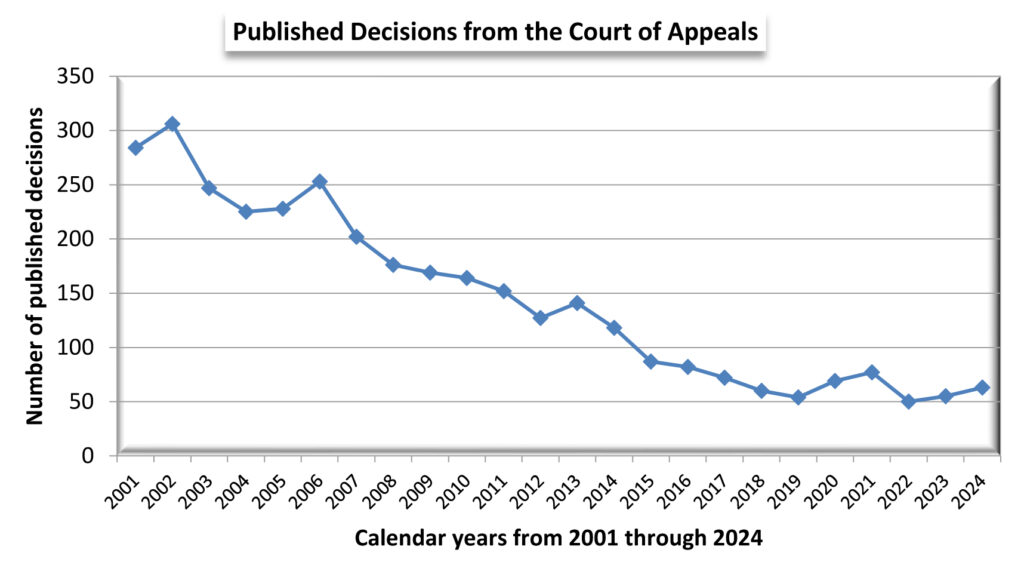
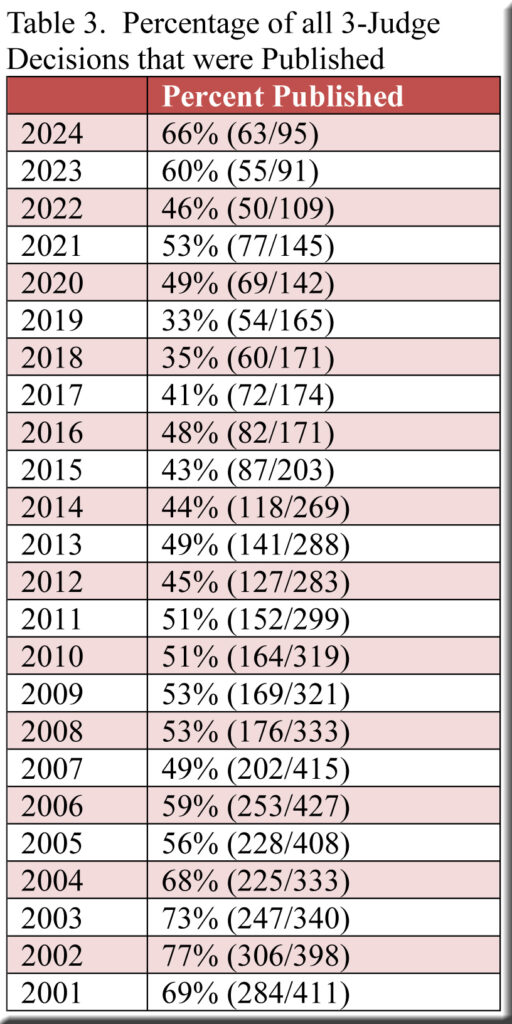
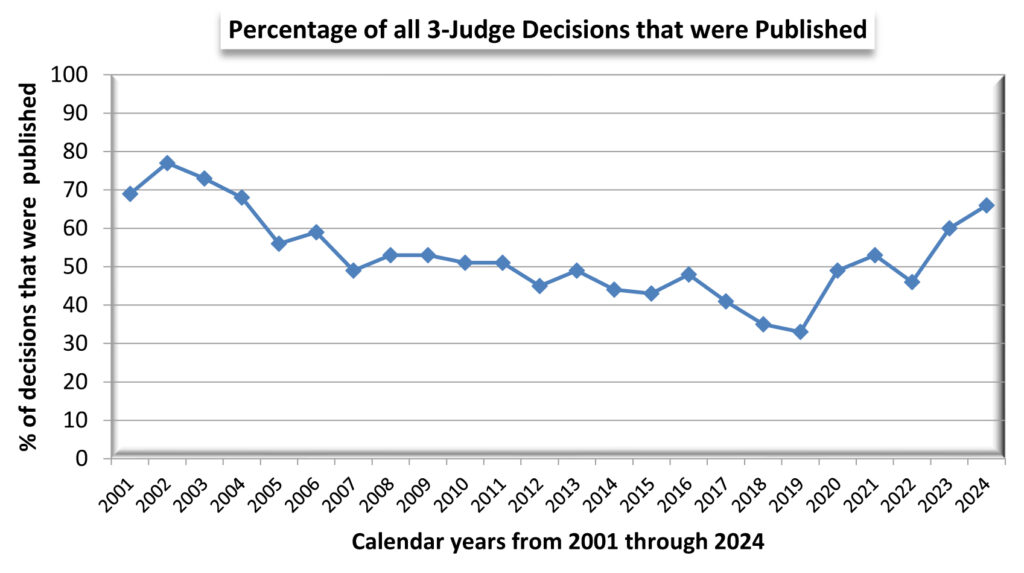
Alan: Doesn’t one have to know the volume of cases and whether it has increased over the years to appreciate the number of decisions? Your analysis of the number of cases that the S. Ct. and the Ct. of Apps. have decided has been an eye opener for me and makes me wonder about the reason that so fewer cases are being decided. Knowing the volumes would be helpful. As always, I greatly appreciate your work. Thank you.
Thank you for the comment, Steve. Regarding the volume of cases reaching the court, it’s something I mentioned in a footnote (below), but I should have included it in the main portion of the post.
Best, Alan.
“This post does not address the question of why the decline occurred, but one factor to consider is the smaller number of cases reaching the court of appeals in the first place: 1601 cases submitted on briefs or (rarely) with oral argument in 2001, down to 874 cases in 2024.”
“Thus, the dwindling number of published decisions left the legal community with an ever-smaller amount of guidance. ”
That’s not correct. Unless the number in a year falls to 0, every year we are getting more guidance. The rate at which new guidance is coming out is decreasing, but the amount of guidance is still increasing.
As the other commenter addresses, too, the number of cases being appealed is highly relevant to whether the total number of cases being decided is something to be concerned about.
One last point – and this ties somewhat back to my first point. One of the reasons for fewer cases being appealed and decided could well be that the appellate courts are working – that more unanswered questions have now been answered, that there is more uncertainty about the law and thus fewer reasonable disagreements to be had among parties that need resolution from a court. So I don’t think it’s necessarily “concerning” to see these numbers going down. More data is needed! (And thank you for all you do with this data.) Percentage split of civil vs. criminal cases would be useful, as would the time it’s taking to get a decision issued.
I think that I can help with your desire for more data, Tom. There’s a great deal available on the court system’s website in the statistical section for the court of appeals (with annual reports back through 2001). This includes the two items that you mentioned—civil/criminal splits and the average number of days to decision—along with much else.
Thanks also for your hypothesis regarding the rapidly dwindling number of decisions—namely, that the appellate courts have been working so effectively in recent years that there are “fewer reasonable disagreements to be had among parties that need resolution from a court.” As a historian, I would be hard-pressed to reach such a conclusion, but perhaps there are readers with extended experience in the legal system who can set me straight. I would be grateful to learn more on this point from seasoned practitioners.